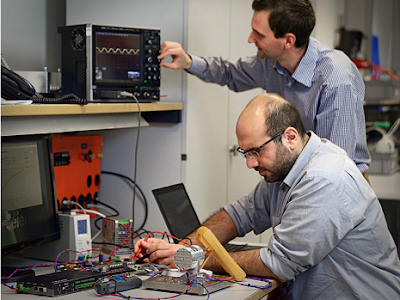domingo, 24 de julho de 2016
A high-speed motor for satellites -ETH Zurich (Department of Information Technology and Electrical Engineering)
22.07.2016 | News By: Peter Rüegg
A dizzying 150,000 revolutions per minute: researchers from ETH Zurich (Department of Information Technology and Electrical Engineering) and the ETH spin-off Celeroton have developed an ultra-fast magnetically levitated electric motor for reaction wheels. The high speed of rotation allows intensive miniaturisation of the drive system, making it attractive for use in small satellites. “Actually, there is nothing particularly new about it,” is the modest line taken by Arda Tüysüz, a postdoc at ETH Zurich’s Power Electronic Systems Laboratory (PES). “The electronics, the magnetic bearings, understanding of the basic physical principle – it was all there already.” However, the engineering skill of the PES researchers is evident in their ability to combine these fundamentals into high-speed motor, which can run 20 times faster than the state of the art, and which is vastly smaller and more energy-efficient. In collaboration with the ETH spin-off Celeroton, Tüysüz and colleagues have developed a new kind of magnetically levitated reaction wheel motor that reaches speeds of more than 150,000 revolutions per minute.
Electrically driven reaction wheels of this kind are used within satellites to change the satellite’s attitude. Here, the reaction wheel is connected to an electric motor via a shaft (rotor). As soon as the flywheel driven by this motor rotates in one direction about its own axis, a torque is transmitted to the satellite, which then rotates in the opposite direction and thus a new orientation.
Existing systems have numerous disadvantages In existing systems, the rotors and reaction wheels are typically mounted on ball bearings that wear down relatively quickly. In order to minimise mechanical wear, motors of this kind are usually operated slower than 6,000 revolutions per minute. They also have to be stored in a hermetically sealed housing in a low-pressure nitrogen atmosphere, in order to avoid oxidisation of the materials and evaporation of the lubricant.
Furthermore, the balls in a ball bearing are not exactly identical, giving rise to forces that together with the imbalance of the rotor transfer microvibrations to the satellite’s housing. This reduces the positioning accuracy, which satellites must exhibit in order to allow, for example, laser measurement or inter-satellite communication. In other words, enough reasons for ETH Zurich and Celeroton to design a new, magnetically levitated electric drive system.
LINK FULL PAPER
https://www.ethz.ch/en/news-and-events/eth-news/news/2016/07/high-speed-motor-for-satellites.html
Assinar:
Postar comentários (Atom)


































 JOSIL ARTISTA PLASTICO FORTALEZA CEARA BRASIL AV.HERACLITO GRAÇA 41 TEL(85)32542378
JOSIL ARTISTA PLASTICO FORTALEZA CEARA BRASIL AV.HERACLITO GRAÇA 41 TEL(85)32542378
















Nenhum comentário:
Postar um comentário